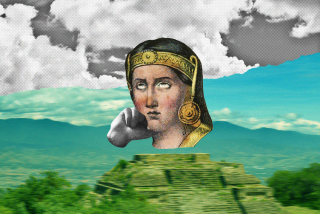Time to Expose Dark Side of Columbus Myth
- Share via
More than 100 years ago, Jose Maria Obregon painted “The Inspiration of Christopher Columbus.” Even then, a romanticized image of the explorer was part of the popular imagination. In the portrait, we see him sitting before the Atlantic, his gaze innocent and his profile sleek, as he prepares to meet his destiny.
This, of course, is the idealized Columbus, the one that has been handed down from one generation to another. As the first European to land in America, he symbolizes the spirit of adventure that for one group of people means courage and masculinity at its best. But there is an underbelly to that image. For native Americans and other dark-skinned peoples, Columbus equals racism and cultural destruction.
U.S. schoolchildren learn that Columbus “discovered” America. The truth is that he stumbled upon a Caribbean island. The myth also propagates the notion that Columbus, with his European culture, civilized what had once been savages. In fact, within two generations of his arrival, massive numbers of people on the Caribbean islands he visited had died due to the diseases and brutality inflicted upon them by their European conquerors.
Perhaps most insidious of all, the myth tells us that Columbus fathered a New World with its implications of new beginnings and new hopes. In actuality, he and his heirs were intruders into long-established political, social and cultural systems. From the southern cone of what is now South America to the northern reaches of Canada, there were thriving and sophisticated societies.
For example, the Aztecs had developed irrigation systems that stumped the Europeans for years. The Maya had integrated the concept of zero into their mathematical calculations--a phenomenon that Europe had earlier imported from Arabic culture.
Seen in such a context, the myth of Columbus is in fact an empty fantasy. When each aspect of the mystique is examined carefully it is found to be wanting. What Christopher Columbus really stands for, without the veil of propaganda, is European society at its worst. From the perspective of people of color, he is the terrible image of the unstoppable Western will to conquer and dominate everything and everyone.
It is the weight and burden of that myth that we must confront in 1992. As part of that acknowledgment, it must be admitted that while the romanticized image of Columbus was not intentionally created, it certainly has been carefully nurtured. There is a brilliance in the clever inversion of what should be a symbol of shame into a source and archetype of cultural pride.
This heritage of denial is still with us, played out every day. One recent example involved the decision by the Pasadena Tournament of Roses to select a descendant of Christopher Columbus as the grand marshal for the Rose Parade of 1992. How apt, parade committee members must have thought, to have the New Year begin by paying homage to the discoverer of the “New World” on the very first day of the 500th anniversary year of his “discovery.” Can’t you just see them now with romantic notions of their historical coup?
Fortunately, they were forced to deal with an angry chorus of anti-Columbian critics who view Columbus in an entirely different light. For these anti-quincentennialists, the “discovery” marks the first great wave of genocide, slavery and greed in the Americas.
I do not think the intention of the anti-Columbus groups is to trash Western European culture, but rather to begin a process of national and cultural reexamination. From their perspective, the desire to idolize Columbus is a highly visible example of the constant emphasis on Western European exploits. To drum this mythology into impressionable schoolchildren, especially if they are the descendants of its victims, is the height of cynical hypocrisy.
We need to do away with such mythical creations and instead begin to inform young people of their true history. Our community leaders--the Richard Alatorres, Gloria Molinas, Art Torreses, the Bill Antons and others--must see to it that there are books, curricula and TV programs that showcase this information. Otherwise, 1992 will pass and with it, a singular opportunity to balance the historical record.
More to Read
The biggest entertainment stories
Get our big stories about Hollywood, film, television, music, arts, culture and more right in your inbox as soon as they publish.
You may occasionally receive promotional content from the Los Angeles Times.










